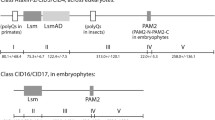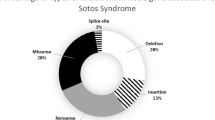Abstract
To understand more fully the structure and evolution of the SOX3 protein, we comparatively analyzed its orthologs in vertebrates. Since complex disorders are associated with human SOX3 polyalanine expansions, our investigation focused on both compositional and evolutionary analysis of various homopolymeric amino acid tracts observed in SOX3 orthologs. Our analysis revealed that the observed homopolymeric alanine, glycine, and proline tracts are mammal-specific, except for one polyglycine tract present in birds. Since it is likely that the SOX3 protein acquired additional roles in brain development in Eutheria, we might speculate that development of novel brain functions during the course of evolution was affected, at least in part, by such structural–functional changes in the SOX3 protein.




Similar content being viewed by others
References
Alba MM, Guigo R (2004) Comparative analysis of amino acid repeats in rodents and humans. Genome Res 14:549–554
Albrecht AN, Kornak U, Boddrich A, Suring K, Robinson PN, Stiege AC, Lurz R, Stricker S, Wanker EE, Mundlos S (2004) A molecular pathogenesis for transcription factor associated poly-alanine tract expansions. Hum Mol Genet 13:2351–2359
Borstnik B, Pumpernik D (2002) Tandem repeats in protein coding regions of primate genes. Genome Res 12:909–915
Bowles J, Schepers G, Koopman P (2000) Phylogeny of the SOX family of developmental transcription factors based on sequence and structural indicators. Dev Biol 227:239–255
Brown LY, Brown SA (2004) Alanine tracts: the expanding story of human illness and trinucleotide repeats. Trends Genet 20:51–58
Caburet S, Vaiman D, Veitia RA (2004) A genomic basis for the evolution of vertebrate transcription factors containing amino acid runs. Genetics 167:1813–1820
Clay O, Caccio S, Zoubak S, Mouchiroud D, Bernardi G (1996) Human coding and noncoding DNA: compositional correlations. Mol Phylogenet Evol 5:2–12
Emili A, Greenblatt J, Ingles CJ (1994) Species-specific interaction of the glutamine-rich activation domains of Sp1 with the TATA box-binding protein. Mol Cell Biol 14:1582–1593
Gao T, Marcelli M, McPhaul MJ (1996) Transcriptional activation and transient expression of the human androgen receptor. J Steroid Biochem Mol Biol 59:9–20
Gerber HP, Seipel K, Georgiev O, Hofferer M, Hug M, Rusconi S, Schaffner W (1994) Transcriptional activation modulated by homopolymeric glutamine and proline stretches. Science 263:808–811
Green H, Wang N (1994) Codon reiteration and the evolution of proteins. Proc Natl Acad Sci USA 91:4298–4302
Guth SIE, Wegner M (2008) Having it both ways: Sox protein function between conservation and innovation. Cell Mol Life Sci 65:3000–3018
Karlin S, Burge C (1996) Trinucleotide repeats and long homopeptides in genes and proteins associated with nervous system disease and development. Proc Natl Acad Sci USA 93:1560–1565
Karlin S, Brocchieri L, Bergman A, Mrazek J, Gentles AJ (2002) Amino acid runs in eukaryotic proteomes and disease associations. Proc Natl Acad Sci USA 99:333–338
Katoh Y, Katoh M (2005) Comparative genomics on SOX2 orthologs. Oncol Rep 14:797–800
Kim MK, Lesoon-Wood LA, Weintraub BD, Chung JH (1996) A soluble transcription factor, Oct-1, is also found in the insoluble nuclear matrix and possesses silencing activity in its alanine-rich domain. Mol Cell Biol 16:4366–4377
Kozak M (1987) An analysis of 5′-noncoding sequences from 699 vertebrate messenger RNAs. Nucleic Acids Res 15:8125–8148
Krstic A, Mojsin M, Kovacevic-Grujicic N, Stevanovic M (2008) PCR amplification and sequence analysis of the rat Sox3 gene. Arch Biol Sci 60:525–530
Laumonnier F, Ronce N, Hamel BC, Thomas P, Lespinasse J, Raynaud M, Paringaux C, Van Bokhoven H, Kalscheuer V, Fryns JP, Chelly J, Moraine C, Briault S (2002) Transcription factor SOX3 is involved in X-linked mental retardation with growth hormone deficiency. Am J Hum Genet 71:1450–1455
Lavoie H, Debeane F, Trinh QD, Turcotte JF, Corbeil-Girard LP, Dicaire MJ, Saint-Denis A, Page M, Rouleau GA, Brais B (2003) Polymorphism, shared functions and convergent evolution of genes with sequences coding for polyalanine domains. Hum Mol Genet 12:2967–2979
Lefebvre V, Dumitriu B, Penzo-Mendez A, Han Y, Pallavi B (2007) Control of cell fate and differentiation by Sry-related high-mobility-group box (Sox) transcription factors. Int J Biochem Cell Biol 39:2195–2214
Mermod N, O’Neill EA, Kelly TJ, Tjian R (1989) The proline-rich transcriptional activator of CTF/NF-I is distinct from the replication and DNA binding domain. Cell 58:741–753
Mitchell PJ, Tjian R (1989) Transcriptional regulation in mammalian cells by sequence-specific DNA binding proteins. Science 245:371–378
Mortlock DP, Sateesh P, Innis JW (2000) Evolution of N-terminal sequences of the vertebrate HOXA13 protein. Mamm Genome 11:151–158
Muragaki Y, Mundlos S, Upton J, Olsen BR (1996) Altered growth and branching patterns in synpolydactyly caused by mutations in HOXD13. Science 272:548–551
Nakachi Y, Hayakawa T, Oota H, Sumiyama K, Wang L, Ueda S (1997) Nucleotide compositional constraints on genomes generate alanine-, glycine-, and proline-rich structures in transcription factors. Mol Biol Evol 14:1042–1049
Oma Y, Kino Y, Toriumi K, Sasagawa N, Ishiura S (2007) Interactions between homopolymeric amino acids (HPAAs). Protein Sci 16:2195–2204
Pask AJ, Harry JL, Renfree MB, Marshall Graves JA (2000) Absence of SOX3 in the developing marsupial gonad is not consistent with a conserved role in mammalian sex determination. Genesis 27:145–152
Ren J, Gao X, Jin C, Zhu M, Wang X, Shaw A, Wen L, Yao X, Xue Y (2009) Systematic study of protein sumoylation: development of a site-specific predictor of SUMOsp 2.0. Proteomics 9:3409–3412
Savare J, Bonneaud N, Girard F (2005) SUMO represses transcriptional activity of the Drosophila SoxNeuro and human Sox3 central nervous system-specific transcription factors. Mol Biol Cell 16:2660–2669
Stevanovic M, Lovell-Badge R, Collignon J, Goodfellow PN (1993) SOX3 is an X-linked gene related to SRY. Hum Mol Genet 2:2013–2018
Sudol M (1996) The WW module competes with the SH3 domain? Trends Biochem Sci 21:161–163
Sumiyama K, Washio-Watanabe K, Saitou N, Hayakawa T, Ueda S (1996) Class III POU genes: generation of homopolymeric amino acid repeats under GC pressure in mammals. J Mol Evol 43:170–178
Uchikawa M, Kamachi Y, Kondoh H (1999) Two distinct subgroups of Group B Sox genes for transcriptional activators and repressors: their expression during embryonic organogenesis of the chicken. Mech Dev 84:103–120
Wegner M (1999) From head to toes: the multiple facets of Sox proteins. Nucleic Acids Res 27:1409–1420
Wong J, Farlie P, Holbert S, Lockhart P, Thomas PQ (2007) Polyalanine expansion mutations in the X-linked hypopituitarism gene SOX3 result in aggresome formation and impaired transactivation. Front Biosci 12:2085–2095
Woods KS, Cundall M, Turton J, Rizotti K, Mehta A, Palmer R, Wong J, Chong WK, Al-Zyoud M, El-Ali M, Otonkoski T, Martinez-Barbera JP, Thomas PQ, Robinson IC, Lovell-Badge R, Woodward KJ, Dattani MT (2005) Over- and underdosage of SOX3 is associated with infundibular hypoplasia and hypopituitarism. Am J Hum Genet 76:833–849
Acknowledgment
This work was supported by the Ministry of Science and Technological Development, Republic of Serbia (Grant No. 143028).
Author information
Authors and Affiliations
Corresponding author
Additional information
Marija Mojsin and Natasa Kovacevic-Grujicic contributed equally to this work.
Electronic supplementary material
Below is the link to the electronic supplementary material.
Rights and permissions
About this article
Cite this article
Mojsin, M., Kovacevic-Grujicic, N., Krstic, A. et al. Comparative Analysis of SOX3 Protein Orthologs: Expansion of Homopolymeric Amino Acid Tracts During Vertebrate Evolution. Biochem Genet 48, 612–623 (2010). https://doi.org/10.1007/s10528-010-9343-2
Received:
Accepted:
Published:
Issue Date:
DOI: https://doi.org/10.1007/s10528-010-9343-2




